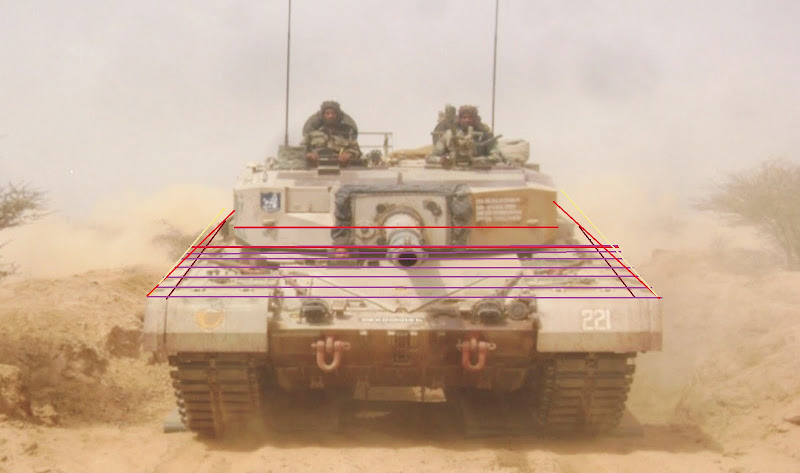https://lh3.googleusercontent.com/-bTYxjnN_Mwo/UPaogo5msWI/AAAAAAAAAAw/egQjKcMZiRA/s640/Arjun.jpg
The shadow of the turret falls on the hull at the third blue line from the top.
it is the place where turret's side wall projection on the hull would fall.
The blue rectangle drawn on the TC's crew hatch cover represent s the true length of the hatch cover .
This rectangle is projected in the correct plane on the hull ,
found out by the downwards projection of the line joining the two hatch covers on the turret top,
to the top of the hull.
This is the perspective drawing as far as I know,
Width over track is 3540 mm.
About half of the crew hatch is enclosed between the red line an the blue line.
The red line indicates the track width border of 3540 mm. Because there needs to be some gap between the inner side of the side skirt and track edges.
That is about 0.50x550 mm=220 mm
3540-(220x2=440 mm)= 3140 mm is the width of the ARJUN turret.
There needs to be a correction factor for taking the same length turret width line which is situated at a depth of the close to 1.5 meter from hull plane . If we apply that the hull width is only going to increase, not decrease.
Because the fixed length rectangle on the hatch cover will measure less length if we bring it in front by 1.5 meters on the hull plane, nearer to the observer( in this case the camera )
Since my opponents here will not accept it as they don't have any idea about Perspective distortion, I haven't included it here.
If some people say the hatch cover is just 500 mm in width , according to this measurement technique the turret width is only going to increase,
So no can try to wiggle out saying that if the hatch cover width decreases the turret width will also decrease when we go for a staight on hatch cover measurement like the one below.
http://img706.imageshack.us/img706/4033/mx3i.jpg
Even if you take a worst case scenario of 3000 mm turret width, giving a very large margin of 140 mm for inaccuracies
1500mm is the distance between outer most side wall of arjun side turret and the turret center line,
1200 mm is the distance between the two crew hatch centers,
1200/2= 600 mm is the distance of Tc' seat edge from the turret center line,
So 1500 mm-600 mm=900 mm is the space available besides the crew hatch center and the outer most side wall of ARJUN turret,




